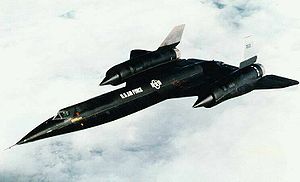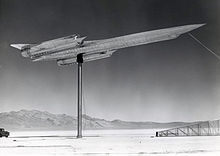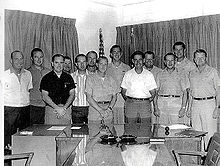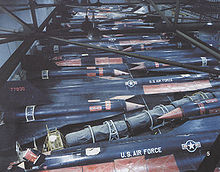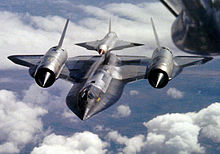- Lockheed A-12
-
A-12 An A-12 aircraft (serial number 06932) Role High-altitude reconnaissance aircraft Manufacturer Lockheed Corporation First flight 25 April 1962 Introduction 1967 Retired 1968 Status Retired Primary user Central Intelligence Agency Number built A-12: 13; M-21: 2 Variants Lockheed YF-12 Developed into Lockheed SR-71 Blackbird The Lockheed A-12 was a reconnaissance aircraft built for the Central Intelligence Agency (CIA) by Lockheed's famed Skunk Works, based on the designs of Clarence "Kelly" Johnson. The A-12 was produced from 1962 through 1964, and was in operation from 1963 until 1968. The single-seat design, which first flew in April 1962, was the precursor to both the twin-seat U.S. Air Force YF-12 prototype interceptor and the famous SR-71 Blackbird reconnaissance aircraft. The aircraft's final mission was flown in May 1968, and the program and aircraft retired in June of that year. Officially secret for over forty years, the CIA began declassifying A-12 program details for release in 2007.[1]
Contents
Design and development
With the failure of the CIA's Project Rainbow to reduce the radar cross section of the U-2, preliminary work began inside Lockheed in late 1957 to develop a follow-on aircraft to overfly the Soviet Union. The designs were nicknamed "Archangel", after the U-2 program, which had been known as "Angel". As the aircraft designs evolved and configuration changes occurred, the internal Lockheed designation changed from Archangel-1 to Archangel-2, and so on. These nicknames for the evolving designs soon simply became known as "A-1", "A-2", etc.[2]
These designs had reached the A-11 stage when the program was reviewed. The A-11 was competing against a Convair proposal called Kingfish, of roughly similar performance. However, the Kingfish included a number of features that greatly reduced its radar cross section, which was seen as favorable to the board. Lockheed responded with a simple update of the A-11, adding twin canted fins instead of a single right-angle one, and adding a number of areas of non-metallic materials. This became the A-12 design. On 26 January 1960, the CIA ordered 12 A-12 aircraft. After selection by the CIA, further design and production of the A-12 took place under the code-name Oxcart.
After development and production at the Skunk Works, in Burbank, California, the first A-12 was transferred to Groom Lake test facility,[3] where on 26 April 1962, Lockheed test pilot Lou Schalk took the A-12 on its shakedown flight. Many internal documents and references to individual aircraft used Johnson's preferred designation, using the prefix, "the Article" for the specific examples. Thus on the A-12's first flight, the subject aircraft was identified as "Article 121". The first official flight occurred on 30 April.[4] On its first supersonic flight, in early May 1962, the A-12 reached speeds of Mach 1.1.
The first five A-12s, in 1962, were initially flown with Pratt & Whitney J75 engines capable of 17,000 lbf (76 kN) thrust each, enabling the J75-equipped A-12s to obtain speeds of approximately Mach 2.0. On 5 October 1962, with the newly developed J58 engines, the A-12 flew with one J75 engine, and one J58 engine. By early 1963, the A-12 was flying with J58 engines, and during 1963 these J58-equipped A-12s obtained speeds of Mach 3.2. Also, in 1963, the program experienced its first loss when, on 24 May, "Article 123"[5] piloted by Kenneth S. Collins crashed near Wendover, Utah.
The reaction to the crash illustrated the secrecy over, and importance of, the project. The CIA called the aircraft an F-105 as a cover story;[6] local law enforcement and a passing family were warned with "dire consequences" to keep quiet about the crash.[5] Each was also paid $25,000 in cash ($179,335 today[7]) to do so; the project often used such cash payments to avoid outside enquiries into its operations.[5] The project received ample funding; contracted security guards were paid $1,000 monthly ($7,173 today[7]) with free housing on base, and chefs from Las Vegas were available 24 hours a day for steak, Maine lobster, or other requests.[5]
In June 1964, the last A-12 was delivered to Groom Lake,[8] from where the fleet made a total of 2,850 test flights.[6] A total of 18 aircraft were built through the program's production run. Of these, 13 were A-12s, three were prototype YF-12A interceptors for the Air Force (not funded under the OXCART program), and two were M-21 reconnaissance drone carriers. One of the 13 A-12s was a dedicated trainer aircraft with a second seat, located behind the pilot and raised to permit the Instructor Pilot to see forward. The A-12 trainer "Titanium Goose", retained the J75 powerplants for its entire service life.[9]
Operational history
Although originally designed to succeed the U-2 in overflights over the Soviet Union and Cuba, the A-12 was never used for either role. After a U-2 was shot down in May 1960, the Soviet Union was considered too dangerous to overfly except in an emergency (and overflights were no longer necessary[10] due to spy satellites) and, although crews trained for the role, U-2s remained adequate for Cuba.[11]
After lengthy debate, the CIA decided to deploy the A-12s to Asia. The first A-12 arrived at Kadena Air Base, Okinawa, Japan, on 22 May 1967. With the arrival of two more aircraft (24 May, and 27 May) the unit was declared operational on 30 May, and began Operation Black Shield on 31 May.[12] Mel Vojvodich flew the first Black Shield operation, over North Vietnam, photographing Surface-to-air missile (SAM) sites, flying at 80,000 ft (24,000 m), and at Mach 3.1. From Kadena, during 1967, the A-12s conducted 22 operations in support of the Vietnam War. During 1968, Black Shield conducted operations in Vietnam and also supported the Pueblo Crisis with North Korea. The operational use of the A-12 was nearly a decade after the original conception of the Oxcart program.
During its deployment on Okinawa, the A-12s (and later the SR-71) and by extension their pilots, were nicknamed Habu after a cobra-like Okinawan pit viper which the locals thought the plane resembled.
Retirement
The A-12 program was officially canceled on 28 December 1966[13] — even before Black Shield began in 1967 — due to budget concerns[14] and because of the forthcoming SR-71, which arrived in Kadena in March 1968.
Ronald L. Layton flew the 29th and final A-12 mission on 8 May 1968, over North Korea. On 4 June 1968, just 2½ weeks before the retirement of the entire A-12 fleet, an A-12 out of Kadena, piloted by Jack Weeks, was lost over the Pacific Ocean near the Philippines while conducting a functional check flight after the replacement of one of its engines.[14][15] Francis J. Murray took the final A-12 flight on 21 June 1968, to Palmdale, California.
On 26 June 1968, Vice Admiral Rufus L. Taylor, the Deputy Director of Central Intelligence, presented the CIA Intelligence Star for valor to Weeks' widow and pilots Collins, Layton, Murray, Vojvodich, and Dennis B. Sullivan for participation in Black Shield.[14][16][17]
The deployed A-12s and the eight non-deployed aircraft were placed in storage at Palmdale. All surviving aircraft remained there for nearly 20 years before being sent to museums around the United States. On 20 January 2007, despite protests by Minnesota's legislature and volunteers who had maintained it in display condition, the A-12 preserved in Minneapolis, Minnesota, was dismantled to ship to CIA Headquarters to be displayed there.[18]
Timeline
The following timeline describes the overlap of the development and operation of the A-12, and the evolution of its successor, the SR-71.
- 16 August 1956: Following Soviet protest of U-2 overflights, Richard M. Bissell, Jr. conducts the first meeting on reducing the radar cross section of the U-2. This evolves into Project Rainbow.
- December 1957: Lockheed begins designing subsonic stealthy aircraft under what will become Project Gusto.
- 24 December 1957: First J-58 engine run.
- 21 April 1958: Kelly Johnson makes first notes on a Mach 3 aircraft, initially called the U-3, but eventually evolving into Archangel I.
- November 1958: The Land panel provisionally selects Convair Fish (B-58-launched parasite) over Lockheed's A-3.
- June 1959: The Land panel provisionally selects Lockheed A-11 over Convair Fish. Both companies instructed to re-design their aircraft.
- 14 September 1959: CIA awards antiradar study, aerodynamic structural tests, and engineering designs, selecting Lockheed's A-12 over rival Convair's Kingfish. Project Oxcart established.
- 26 January 1960: CIA orders 12 A-12 aircraft.
- 1 May 1960: Francis Gary Powers is shot down in a U-2 over the Soviet Union.
- 26 April 1962: First flight of A-12 with Lockheed test pilot Louis Schalk at Groom Lake.
- 13 June 1962: SR-71 mock-up reviewed by USAF.
- 30 July 1962: J58 engine completes pre-flight testing.
- October 1962: A-12s first flown with J58 engines
- 28 December 1962: Lockheed signs contract to build six SR-71 aircraft.
- January 1963: A-12 fleet operating with J58 engines
- 24 May 1963: Loss of first A-12 (#60–6926)
- 7 August 1963: First flight of the YF-12A with Lockheed test pilot James Eastham at Groom Lake.
- June 1964: Last production A-12 delivered to Groom Lake.
- 25 July 1964: President Johnson makes public announcement of SR-71.
- 29 October 1964: SR-71 prototype (#61-7950) delivered to Palmdale.
- 22 December 1964: First flight of the SR-71 with Lockheed test pilot Bob Gilliland at AF Plant #42. First mated flight of the MD-21 with Lockheed test pilot Bill Park at Groom Lake.
- 28 December 1966: Decision to terminate A-12 program by June 1968.
- 31 May 1967: A-12s conduct Black Shield operations out of Kadena
- 3 November 1967: A-12 and SR-71 conduct a reconnaissance fly-off. Results were questionable.
- 26 January 1968: North Korea A-12 overflight by Jack Weeks photo-locates the captured USS Pueblo in Changjahwan Bay harbor.[19]
- 5 February 1968: Lockheed ordered to destroy A-12, YF-12 and SR-71 tooling.
- 8 March 1968: First SR-71A (#61-7978) arrives at Kadena AB (OL 8) to replace A-12s.
- 21 March 1968: First SR-71 (#61-7976) operational mission flown from Kadena AB over Vietnam.
- 8 May 1968: Jack Layton flies last operational A-12 sortie, over North Korea.
- 5 June 1968: Loss of last A-12 (#60–6932)
- 21 June 1968: Final A-12 flight to Palmdale, California.
For the continuation of the Oxcart timeline, covering the duration of operational life for the SR-71, see SR-71 timeline.
Variants
Training variant
 The only two-seat trainer A-12 built was nicknamed "Titanium Goose". It is on display at the California Science Center.
The only two-seat trainer A-12 built was nicknamed "Titanium Goose". It is on display at the California Science Center.
The A-12 training variant (60-692 "Titanium Goose") was a two-seat model with two cockpits set horizontally with the rear cockpit raised and slightly offset. In case of emergency, the trainer was designed to allow the flight instructor to take control. Other than the modifications required to accommodate the dual controls and new cockpit configuration, the trainer was very similar to A-12 in terms of appearance and performance.
YF-12A
The YF-12 program was a limited production variant of the A-12. Lockheed convinced the U.S. Air Force that an aircraft based on the A-12 would provide a less costly alternative to the recently canceled North American Aviation XF-108, since much of the design and development work on the YF-12 had already been done and paid for. Thus, in 1960 the Air Force agreed to take the seventh through ninth slots on the A-12 production line and have them completed in the YF-12A interceptor configuration.[20]
The main changes involved modifying the aircraft's nose to accommodate the Hughes AN/ASG-18 fire-control radar originally developed for the XF-108, and the addition of a second cockpit for a crew member to operate the fire control radar. The nose modifications changed the aircraft's aerodynamics enough to require ventral fins to be mounted under the fuselage and engine nacelles to maintain stability. Finally, bays previously used to house the A-12's reconnaissance equipment were converted to carry missiles.
M-21
One notable variant of the basic A-12 design was the M-21, used to carry and launch the Lockheed D-21, an unmanned, faster and higher-flying reconnaissance drone. The M-21 was a modified version of the A-12 with a second cockpit for a Launch Control Operator/Officer (LCO) in the place of the A-12's Q bay; the M-21 also included a pylon on its back for mounting the drone.[21] The D-21 was completely autonomous; after being launched it would overfly the target, travel to a predetermined rendezvous point and eject its data package. The package would be recovered in midair by a C-130 Hercules and the drone would self-destruct.[22]
The program to develop this system was canceled in 1966 after a drone collided with the mother ship at launch, destroying the M-21. The crew survived the midair collision but the LCO drowned when he landed in the ocean and his flight suit filled with water.[23] The modified D-21B drone was carried on a pylon under the wing of the B-52 bomber. The drone performed operational missions over China from 1969 to 1971.[24]
A-12 aircraft production and disposition
List of A-12s Serial number Model Location or fate 60-6924 A-12 Air Force Flight Test Center Museum Annex, Blackbird Airpark, at Plant 42, Palmdale, California. 606924 was the first A-12 to fly. 60-6925 A-12 Intrepid Sea-Air-Space Museum, parked on the deck of the aircraft carrier USS Intrepid, New York City 60-6926 A-12 Lost, 24 May 1963 60-6927 A-12 California Science Center in Los Angeles, CA (Two-canopied trainer model, "Titanium Goose") 60-6928 A-12 Lost, 5 January 1967 60-6929 A-12 Lost, 28 December 1967 60-6930 A-12 U.S. Space and Rocket Center, Huntsville, Alabama 60-6931 A-12 CIA Headquarters, Langley, Virginia[N 1] 60-6932 A-12 Lost, 4 June 1968 60-6933 A-12 San Diego Aerospace Museum, Balboa Park, San Diego, California 60-6937 A-12 Southern Museum of Flight, Birmingham, Alabama 60-6938 A-12 Battleship Memorial Park (USS Alabama), Mobile, Alabama 60-6939 A-12 Lost, 9 July 1964 60-6940 M-21 Museum of Flight, Seattle, Washington 60-6941 M-21 Lost, 30 July 1966 Specifications (A-12)
Data from A-12 Utility Flight Manual,[25] Pace[26]
General characteristics
- Crew: 1 (2 for trainer variant)
- Length: 101.6 ft (30.97 m)
- Wingspan: 55.62 ft (16.95 m)
- Height: 18.45 ft (5.62 m)
- Wing area: 1,795 ft² (170 m²)
- Empty weight: 54,600 lb (24,800 kg)
- Loaded weight: 124,600 lb (56,500 kg)
- Powerplant: 2 × Pratt & Whitney J58-1 continuous bleed-afterburning turbojets, 32,500 lbf (144 kN) each
- Payload: 2,500 lb (1,100 kg) of reconnaissance sensors
Performance
- Maximum speed: Mach 3.35 (2,210 mph, 3,560 km/h) at 75,000 ft (23,000 m)
- Range: 2,200 nmi (2,500 mi, 4,000 km)
- Service ceiling: 95,000 ft (29,000 m)
- Rate of climb: 11,800 ft/min (60 m/s)
- Wing loading: 65 lb/ft² (320 kg/m²)
- Thrust/weight: 0.56
See also
- Related development
- Aircraft of comparable role, configuration and era
- Related lists
References
- Notes
- ^ "Article 128", unveiled on Wednesday, 19 September 2007, at CIA Headquarters in Langley, VA. On hand was Ken Collins, a retired Air Force Colonel, one of only six pilots to fly the A-12s.
- Citations
- ^ Jacobsen, Annie (5 April 2009). "The Road to Area 51". Los Angeles Times. http://latimes.com/entertainment/la-mag-april052009-backstory,0,5104077.story. Retrieved 10 September 2011.
- ^ "The U-2's Intended Successor: Project Oxcart 1956–1968". Central Intelligence Agency, approved for release by the CIA in October 1994. Retrieved: 26 January 2007.
- ^ Jacobson 2011, p. 51.
- ^ "A-12 First Flight." Lockheed Martin. Retrieved: 13 October 2010.
- ^ a b c d Lacitis, Erik. "Area 51 vets break silence: Sorry, but no space aliens or UFOs." The Seattle Times, 27 March 2010.
- ^ a b Jacobsen, Annie. "The Road to Area 51." Los Angeles Times, 5 April 2009.
- ^ a b Consumer Price Index (estimate) 1800–2008. Federal Reserve Bank of Minneapolis. Retrieved December 7, 2010.
- ^ "SR-71 Blackbird." Lockheed Martin. Retrieved: 13 October 2010.
- ^ Landis and Jenkins 2005, p. 16.
- ^ McIninch 1996, p. 19.
- ^ McIninch 1996, p. 20.
- ^ McIninch 1996, pp. 25–27.
- ^ McIninch 1996, p. 31.
- ^ a b c Robarge, David. "A Futile Fight for Survival. Archangel: CIA's Supersonic A-12 Reconnaissance Aircraft." U.S. Central Intelligence Agency, Center for the Study of Intelligence, CSI Publications, 27 June 2007. Retrieved: 13 April 2009.
- ^ McIninch 1996, p. 33.
- ^ McIninch 1996, p. 34.
- ^ Hayden, General Michael V. "General Hayden's Remarks at A-12 Presentation Ceremony." Central Intelligence Agency, Remarks of Director of the Central Intelligence Agency at the A-12 Presentation Ceremony, 19 September 2007. Retrieved: 10 April 2009.
- ^ Karp, Jonathan. "Stealthy Maneuver: The CIA Captures An A-12 Blackbird". The Wall Street Journal, A1, 26 January 2007. Retrieved: 10 April 2009.
- ^ Jacobson 2011, p. 273.
- ^ Landis and Jenkins 2005, pp. 40–41.
- ^ Landis and Jenkins 2005, pp. 22–24.
- ^ Donald 2003, pp. 154–155.
- ^ "MD-21 crash footage." YouTube. Retrieved: 13 October 2010.
- ^ Donald 2003, pp. 155–156.
- ^ "A-12 Utility Flight Manual (Copy 15, Version 15 September 1968)." CIA, 15 June 1968. Retrieved: 5 April 2010.
- ^ Pace 2004, pp. 105, 110.
- Bibliography
- Donald, David, ed. "Lockheed's Blackbirds: A-12, YF-12 and SR-71". Black Jets. Norwalk, CT: AIRtime, 2003. ISBN 1-880588-67-6.
- Jacobson, Annie (2011). Area 51. London: Orion Publishing. ISBN 9781409141136.
- Landis, Tony R. and Dennis R. Jenkins. Lockheed Blackbirds. Minneapolis, Minnesota: Specialty Press, revised edition, 2005. ISBN 1-58007-086-8.
- McIninch, Thomas. "THE OXCART STORY" Center for the Study of Intelligence, Central Intelligence Agency, 2 July 1996. Retrieved 10 April 2009.
- Pace, Steve. Lockheed SR-71 Blackbird. Swindon: Crowood Press, 2004. ISBN 1-86126-697-9.
- Additional sources
- Graham, Richard H. SR-71 Revealed: The Inside Story. St. Paul, Minnesota: MBI Publishing Company, 1996. ISBN 978-0-7603-0122-7.
- Jenkins, Dennis R. Lockheed Secret Projects: Inside the Skunk Works. St. Paul, Minnesota: MBI Publishing Company, 2001. ISBN 978-0-7603-0914-8.
- Johnson, C.L. Kelly: More Than My Share of it All. Washington, DC: Smithsonian Books, 1985. ISBN 0-87474-491-1.
- Lovick, Edward, Jr. Radar Man: A Personal History of Stealth. Bloomington, IN: iUniverse, 2010. ISBN 978-1-45024-802-0.
- Merlin, Peter W. From Archangel to Senior Crown: Design and Development of the Blackbird (Library of Flight Series). Reston, Virginia: American Institute of Aeronautics and Astronautics (AIAA), 2008. ISBN 978-1-56347-933-5.
- Pedlow, Gregory W. and Donald E. Welzenbach. The Central Intelligence Agency and Overhead Reconnaissance: The U-2 and OXCART Programs, 1954–1974. Washington, DC: Central Intelligence Agency, 1992. ISBN 0-7881-8326-5.
- Rich, Ben R. and Leo Janos. Skunk Works: A Personal Memoir of My years at Lockheed. New York: Little, Brown and Company, 1994. ISBN 0-316-7433.
- Shul, Brian and Sheila Kathleen O'Grady. Sled Driver: Flying the World's Fastest Jet. Marysville, California: Gallery One, 1994. ISBN 0-929823-08-7.
- Suhler, Paul A. From RAINBOW to GUSTO: Stealth and the Design of the Lockheed Blackbird (Library of Flight Series) . Reston, Virginia: American Institute of Aeronautics and Astronautics (AIAA), 2009. ISBN 978-1-60086-712-5.
External links
- Archangel: CIA's Supersonic A-12 Reconnaissance Aircraft by David Robarge. (Cia.gov)
- FOIA documents on OXCART (Declassified 21 January 2008)
- "Sheep Dipping" Conversion of Air Force Officers to CIA For Project Oxcart
- A-12 page on RoadRunners Internationale site
- A-12T Exhibit at California Science Center
- Differences between the A-12 and SR-71
- Blackbird Spotting maps the location of every existing Blackbird, with aerial photos from Google Maps
- Photographs and disposition of the "Habu" aircraft at habu.org
- The U-2's Intended Successor: Project Oxcart (Chapter 6 of "The CIA and Overhead Reconnaissance", by Pedlow & Welzenbach)
- USAF Aircraft Serial Numbers for 1960, including all A-12s, YF-12As and M-21s
- "The Real X-Jet". Air & Space magazine, March 1999.
- Secret A-12 Spy Plane Officially Unveiled at CIA's Headquarters
- Project Oxcart: CIA Report
Lockheed and Lockheed Martin aircraft Manufacturer
designationsBasic Model
NumbersL-1 · L-2 · L-3 · L-4 · L-5 · L-7 · L-8 · L-9 · L-10 · L-11 · L-012 · (L-013 not assigned) · L-014 · L-015 · L-016 · L-017 · L-018 · L-019 · L-020 · L-021 · L-022 · L-023 · L-024 · (L-025 not assigned) · L-026 · L-027 · (L-028 not assigned) · L-029 · L-030 · L-031 · L-032 · L-033 · L-034 · L-035 · (L-036 not assigned) · L-037 · (L-038 and L-039 not assigned) · L-040 · L-041 · L-042 · L-044 · L-045 · L-049 · L-050 · L-051 · L-052 · L-060 · L-061 · L-062 · L-075 · L-080 · L-081 · L-082 · L-083 · L-084 · L-085 · L-086 · L-087 · L-088 · L-089 · L-090 · L-091 · L-092 · L-093 · L-094 · L-092 · L-099 · L-100 · L-133 · L-140 · L-141 · L-193 · L-245 · L-246 · L-300 · L-301 · L-329 · L-351 · L-382 · L-500 · L-645
Lockheed-California
Temporary Design
NumbersBy role Airliners and
civil transportsVega · Sirius · Altair · Orion · Electra · Electra Junior · Super Electra · Lodestar · Constellation (L-049 · L-649 · L-749) · Super Constellation (L-1049 · L-1249) · Starliner · Saturn · Electra · L-402 · JetStar · L-100 · L-1011
Military transportsY1C-12 · Y1C-17 · Y1C-23 · Y1C-25 · C-36 · C-37 · C-40 · C-56 · C-57 · C-59 · C-60 · C-63 · C-66 · C-69 · UC-85 · UC-101 · C-104 · C-111 · C-121 · C-130 / C-130J / HC-130 / KC-130 / LC-130 / MC-130 · C-139 · C-140 · C-141 · C-5 · JO · XRO · R2O · R3O · XR4O · R5O · R6O / R6V · R7O / R7V · R8V / GV / UV · TriStar
Attack and bombersDrones/UAVsEW and
reconnaissanceFightersHelicoptersMaritime patrolTrainersExperimentalNames Air Express · Aquila · Altair · Aurora · Big Dipper · Blackbird · Chain Lightning · Cheyenne · Constellation (L-049 · L-649 · L-749) · Constitution · Electra (Model 10) · Electra (Model 88) · Electra Junior · Excalibur · Explorer · Fighting Falcon · Galaxy · Have Blue · Hercules · Hudson · Hummingbird · JetStar · Kestrel · Kingfisher · Lightning · Lightning II · Little Dipper · Lodestar · Neptune · Orion (Model 9) · Orion (P-3) · Polecat · Raptor · Saturn · SeaStar · Sentinel · Shooting Star · Sirius · Starfighter · Starfire · Starlifter · Starliner · Super Constellation (L-1049 · L-1249) · Super Electra · Super Galaxy · Super Hercules · Tristar · Vega · Ventura · Viking · Warning Star
Lists relating to aviation General Aircraft (manufacturers) · Aircraft engines (manufacturers) · Airlines (defunct) · Airports · Civil authorities · Museums · Registration prefixes · Rotorcraft (manufacturers) · TimelineMilitary Accidents/incidents Records Categories:- Lockheed aircraft
- Signals intelligence
- United States military reconnaissance aircraft 1960–1969
- Twinjets
Wikimedia Foundation. 2010.

